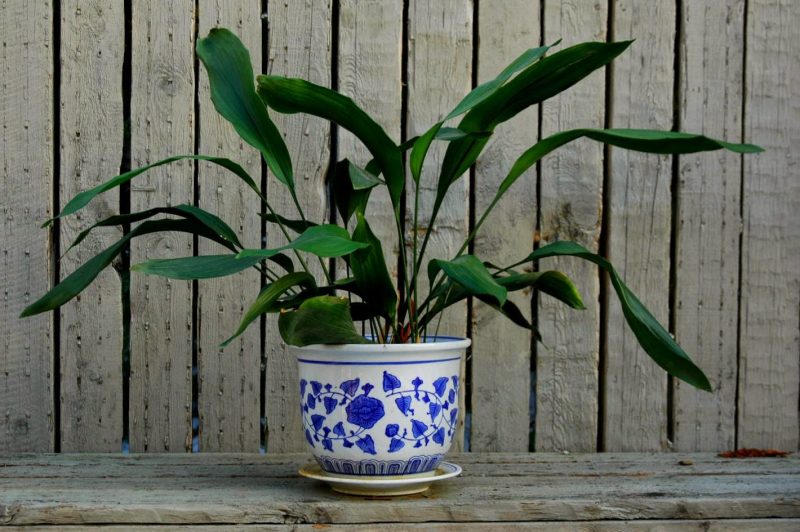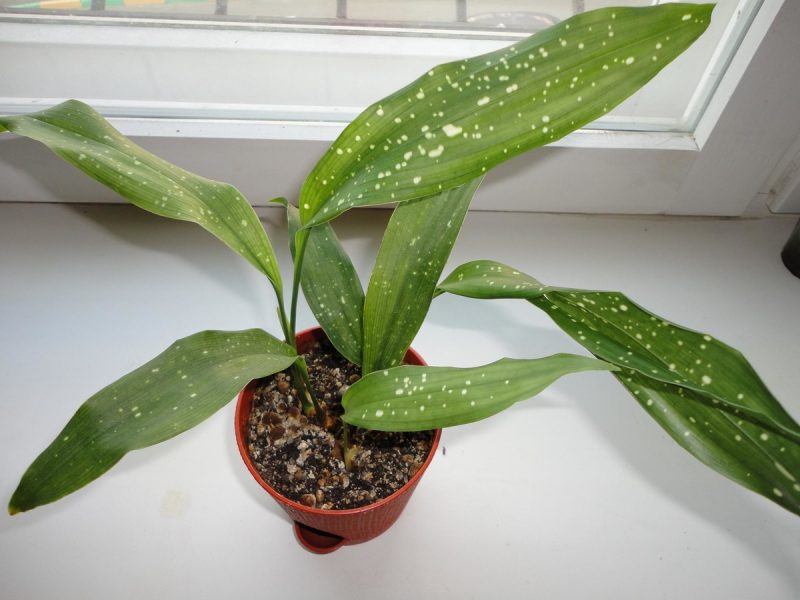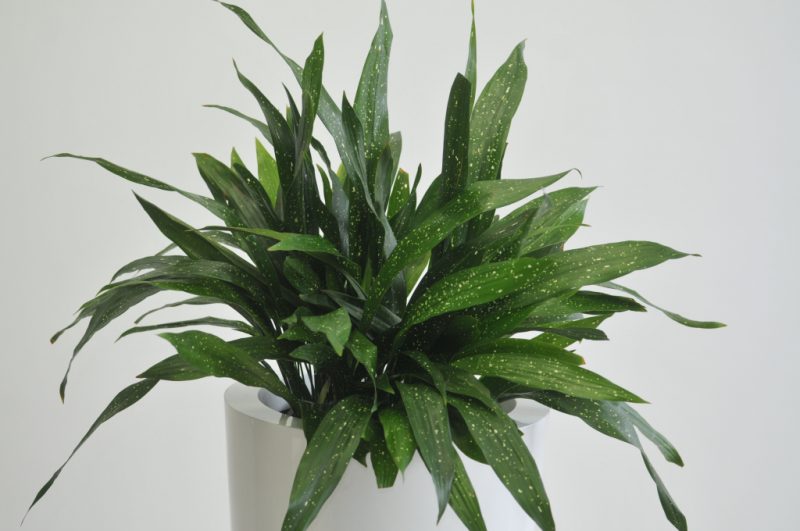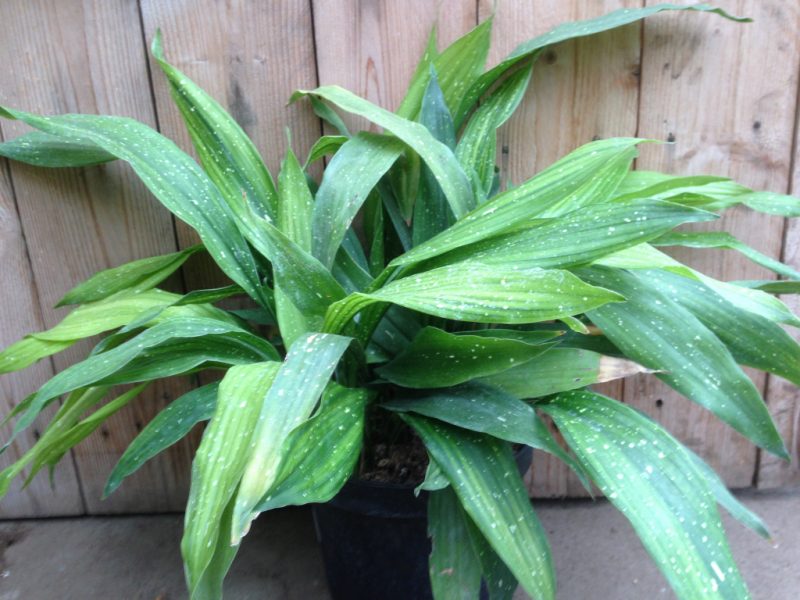For those who do not have time for painstaking care of indoor plants, but want to see a pot of herbs on the windowsill, an aspidistra is suitable. This is a completely undemanding flower. It feels good in dark and cold rooms, withstands irregular watering and soil nutrition. For this, the people call him “Iron Lady”.
Material Content:
Types and varieties of aspidistra
Aspidistra is a perennial, leafless plant with a powerful root system spreading in the ground and belongs to the lily family. Long leaves on the cuttings grow from the root very densely to each other, for which they received the popular name "friendly family". The leaf length of an adult plant can reach 60 cm and a width of 10 cm. The leaf surface is shiny and covered with relief veins. The aspidistra blooms with small, near-earth flowers of pink or purple in shape resembling bells. Unfortunately, flowering is extremely rare at home. With the help of artificial pollination, pear-shaped berries grow from them.

In vivo, there are about 8 species. “Domesticate” managed only one species - Aspidistra high.
Breeders managed to develop several varieties of the original plant species, the difference of which, in the shape and color of the leaves:
- Variegata - a variety with leaves, on a dark green background which are beige stripes.
- Milky Way - this variety got its name for small specks of beige and white, different sizes on green leaves.
- Snow Cap - tapered tips of white leaves. It looks very interesting.
- Okame - features a wide sheet with bright white stripes. This color can be painted up to 50% of the sheet area.
- Asahi - in the middle of the sheet, a white streak passes through the entire length, with an extension of thickness at its end.
- To Ryu Mon - veins on the leaves are light green in color, and their top is bordered by a white stripe.
- Green Ball is an unusual variety, characterized by a long petiole. The sheet itself is very wide and curled, the color is darker than usual, and its length is less than the petiole.
- Stars ‘n Stripes - This variety is tall and reaches a height of up to 90 cm. Large leaves are painted with light green and white stripes. Even in coloring, there are small specks.
Varieties do not end there. Every year, breeders develop new and interesting varieties, with leaves of different sizes and various colors.
Agricultural cultivation
Growing a plant is a simple and troublesome process. It does not require a special soil composition, so ordinary soil from a garden or a garden, universal soil from a store is suitable for planting. You can place the pot with the plant in any, even the most obscured, corner of the room, but you should protect it from prolonged exposure to sunlight. They can burn the leaves of a flower. As lighting, you can use artificial light.

The containers where the flower will grow must be of large volume, so that there is room for the development of the root system. The plant does not like strong waterlogging, therefore, the presence of drainage at the bottom of the pot is necessary.
Optimal conditions

The best place for the growth of aspidistra is considered to be a partial shade or a room whose windows face east. So the negative impact of direct sunlight will be minimal. The optimum temperature for the plant in summer is 20 - 22 degrees, and in winter - 15 - 17 degrees. In winter, a lower temperature of the content stimulates the further growth and development of the flower. In dry and hot air, leaves may turn yellow and dry, so you need to try to moisten the room by spraying.
Read also:Azalea: home care
Care for aspidistra at home

Care is as follows:
- Watering should be moderate. Do not allow an excess of moisture, but also complete drying of the soil, too. In the intervals between watering, the ground should dry by 2 - 3 cm. On hot summer days, you should pay more attention to soil moisture and additionally spray the leaves.
- For dense, juicy and bright leaves, the plant requires top dressing. Often use universal liquid fertilizers. Top dressing is carried out in the period from May to September with an interval of 2 weeks.
- In the process of growth and development of the root system, the flower should be transplanted into larger pots. Aspidistra grows slowly, which is why it is transplanted every 3 to 4 years. This must be done with extreme caution so as not to damage the roots. To do this, let the earth dry well, completely remove the entire earthen lump and move it to a new container. So the transplant will be better tolerated by the plant.
- It is also recommended in the spring and summer to take these flowers to the street or balcony, wash the leaves once a month in the shower.
Reproduction of indoor flower

Reproduction is carried out in two ways:
- Rhizome division. For this, the root system is cut with a knife so that in each part there are 5-6 leaves. Slices of the roots are sprinkled with charcoal, planted in a prepared container with earth and watered. The flower takes root quickly enough. The main thing in this period is to produce accurate watering. Excess moisture is strictly prohibited, because not rotten roots can rot. You can feed only a month after planting. This method of propagation is usually combined with a flower transplant.
- Reproduction by leaf. In the summer, the dried leaf, cut from the petiole, is placed in a glass container with water and restrict air access with a tight lid. This container should be in a well-lit, warm room until the roots begin to grow.Then the sprouted leaf is planted in the ground and covered with a jar, creating the effect of a greenhouse. The jar is cleaned when the seedling is rooted. The rooting is indicated by the appearance of a new leaf.
Pest and Disease Control
Aspidistra is rarely attacked by pests. In these rare cases, it can mainly be affected by a spider mite and scab.
If a scale insect is found, adult insects are removed manually, and the plant is treated with soapy water. If the defeat is total, it is necessary to use a special drug (Fufanon, Karbofos).

Spider mites are fought with a solution of ethyl alcohol and an aqueous solution of laundry soap. For severe lesions, treatment with Actellik is used.
Important! The most dangerous disease in which the flower can only be disposed of is infectious chlorosis. In this case, the growth slows down, the leaves turn sharply and massively yellow. At the first signs of the disease, the aspidistra should be thrown out so as not to infect the remaining available indoor plants.
The result of very frequent watering is the defeat of the flower by root rot. Signs of this disease are that the flower discards leaves and begins to fade. To combat rot, the plant should be transplanted into another pot, and cut the affected areas of the roots and sprinkle with activated charcoal. From now on, control the schedule and abundance of watering.
Signs of Inadequate Care for Aspidistra
Often, flower disease and a change in its condition are not associated with infection, fungus, or pests. As a rule, these are the consequences of not entirely correct care for him.

Bringing a plant back to normal is not difficult:
- Brown and dry spots on the leaves are burns from direct sunlight, the place and lighting were not chosen correctly. The flower pot must be moved to a shaded place.
- The color of the leaves fades, loses its brightness - this is the result of insufficient light. Although aspidistra is a shade-loving plant, it also needs lighting that needs to be provided.
- The lack of regular feeding in the spring-summer period leads to a lack of nutrients, which slows down the growth of the flower.
- The tips of the leaves turn brown and dry - very dry indoor air. Constant humidification will help to cope with this problem.
- Poor drainage or lack of it leads to stagnation of water in the soil, resulting in withering leaves.
It is interesting:aloe at home
Aspidistra fits perfectly into any interior room, decorate office space. With proper care, it will delight you with beautiful, bright green leaves for many years. The leaves of the aspidistra were loved by florists, who use them when arranging bouquets. They retain their natural look for a long time and serve as decoration for any floral arrangement.












